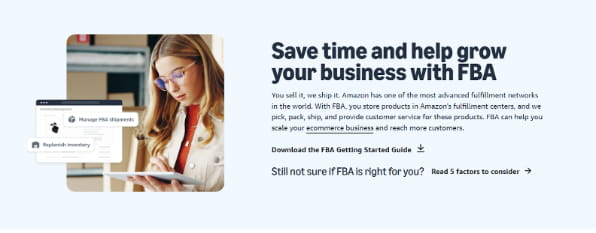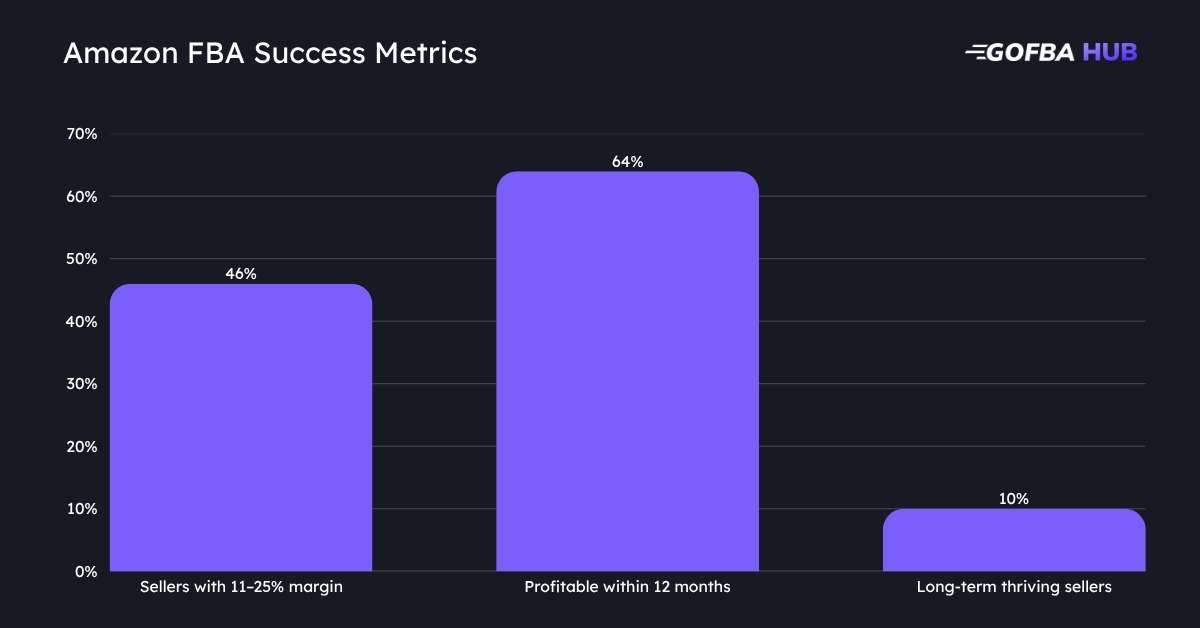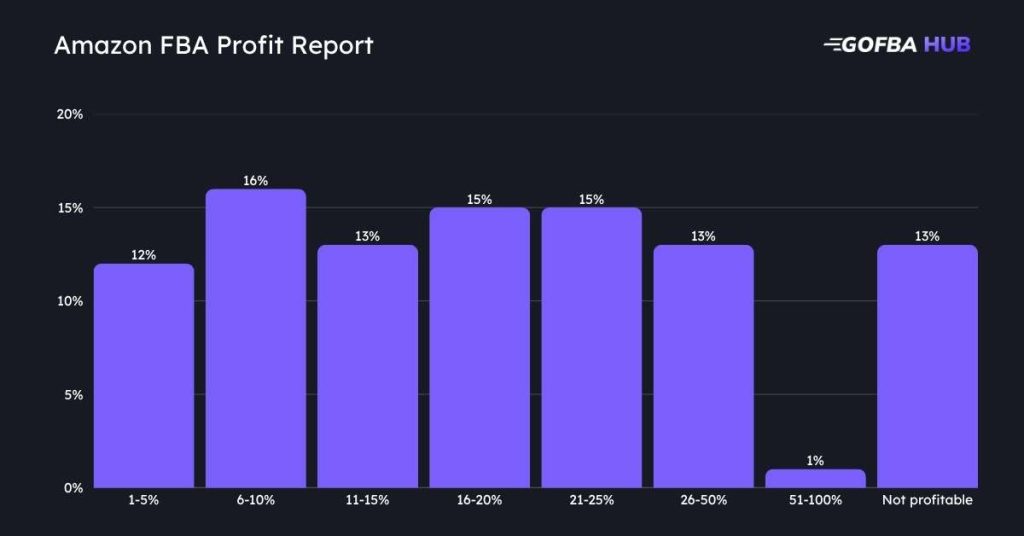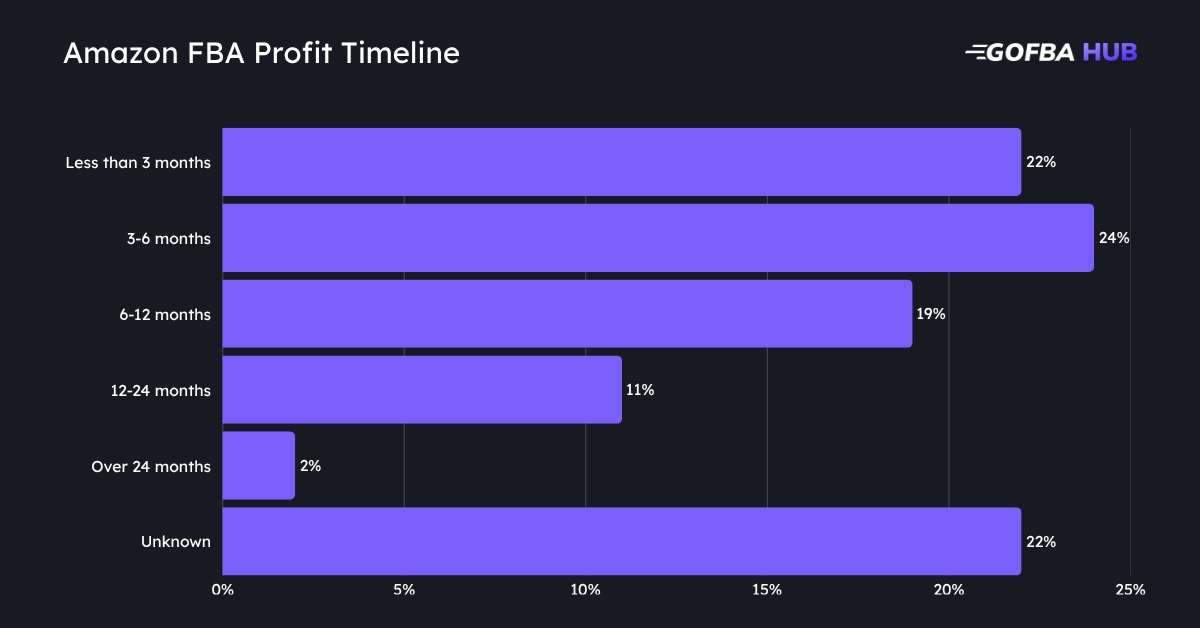Amazon FBA (Fulfillment by Amazon) is a service that allows Amazon to handle storage, packaging, and shipping for sellers. Success rates are measured through profitability, revenue generation, and business longevity.
Amazon doesn’t release official success statistics, making it challenging to determine exact figures. However, various industry studies and surveys provide insights into seller performance.
I’ll examine multiple data sources to give you a realistic picture of FBA success rates, covering profitability metrics, revenue benchmarks, and long-term business sustainability.
Is Amazon FBA Profitable In 2025?
Amazon FBA remains profitable for many sellers in 2025. Recent data show that 64% of Amazon sellers become profitable within their first year, while 46% achieve profit margins between 11% and 25%.

However, long-term success is more challenging, with only 10-20% of sellers sustaining their success beyond the initial years.
Disclaimer: The statistical data referenced represents the most recent information available online, which may differ or fluctuate over time based on market conditions and Amazon policy changes.
What Is The Amazon FBA Success Rate For Businesses?
Success rates vary significantly based on your niche selection, the level of competition, and the practical implementation of your business strategy. Understanding these Amazon statistics provides valuable context for evaluating your potential success in the marketplace.

Here is the statistical data for a better understanding of the success metric of Amazon FBA:
| Success Metric | Percentage/Statistic |
|---|---|
| Sellers with 11–25% margin | 46% |
| Profitable within 12 months | 64% |
| Long-term thriving sellers | ~10% |
Source: Jungle Scout
These numbers reveal that while initial profitability is achievable, sustained success requires dedication and strategic planning.
How Much Revenue Do Amazon FBA Sellers Make?
Understanding revenue potential helps set realistic expectations for your Amazon FBA journey.
Most sellers (70%) generate between $500 and $25,000 monthly, with 40% falling in the $1,000-$25,000 range.
| Monthly Sales | Percentage of Sellers |
|---|---|
| Under $500 | 31% |
| $501-$1,000 | 17% |
| $1,001-$5,000 | 22% |
| $5,001-$10,000 | 11% |
| $10,001-$25,000 | 7% |
| $25,001-$50,000 | 5% |
| $50,001-$100,000 | 4% |
| $100,001-$250,000 | 1% |
| $251,000-$500,000 | 1% |
The data reveal a steep revenue pyramid, where nearly half (48%) of sellers earn under $1,000 monthly, indicating significant barriers to entry and success.
Only 12% achieve monthly revenues exceeding $25,000, highlighting the elite nature of top-performing sellers who’ve mastered product selection, marketing, and operational efficiency in Amazon’s competitive marketplace.
For those considering alternatives, comparing Amazon FBA vs Shopify can help determine which platform better suits your business model and revenue goals.
How Much Profit Do Amazon FBA Sellers Make?
Revenue means nothing without understanding actual profit margins after all expenses and fees are accounted for.
57% of Amazon sellers achieve profit margins greater than 10%, while 28% earn at least 20%. However, 13% remain unprofitable.

| Profit Margin | Percentage of Sellers |
|---|---|
| 1-5% | 12% |
| 6-10% | 16% |
| 11-15% | 13% |
| 16-20% | 15% |
| 21-25% | 15% |
| 26-50% | 13% |
| 51-100% | 1% |
| Not profitable | 13% |
The profit distribution shows remarkable consistency across margin ranges, with each 5% bracket representing 12-16% of sellers. This indicates that there are diverse business models and cost structures across the platform.
The 13% achieving exceptional margins above 25% likely represent niche products or highly optimized operations, while unprofitable sellers highlight ongoing challenges with Amazon’s fee structure. Many sellers explore different fulfillment models, such as Amazon FBA and dropshipping, to optimize their profit margins.
How Long Does It Take To Make a Profit On Amazon FBA?
Timing expectations are crucial for planning your Amazon FBA venture and financial commitments. Most Amazon sellers become profitable faster than traditional brick-and-mortar businesses.

| Time Required | Seller Percentage |
|---|---|
| Less than 3 months | 22% |
| 3-6 months | 24% |
| 6-12 months | 19% |
| 12-24 months | 11% |
| Over 24 months | 2% |
| Unknown | 22% |
58% of sellers achieve profitability within their first year, with 22% reaching profit in under three months. Successful sellers often leverage tools like Helium 10’s Brand Analytics to accelerate their path to profitability.
This timeline depends heavily on your product selection, marketing effectiveness, and initial investment levels for inventory and advertising.
How Much Does It Cost To Sell On Amazon FBA?
Understanding costs is essential for calculating your potential success rate.
Amazon FBA Fees:
- Referral fees: Commission paid to Amazon (typically 15% or less)
- FBA fulfillment fees: Based on product size and weight ($3.22+ per item)
- Monthly storage fees: $0.87 per cubic foot (January-September)
- Professional account fee: $39.99 monthly subscription
- Aged inventory fees: Additional charges for slow-moving inventory
Source: Amazon Seller Central Fee Structure
Most sellers start with $5,000 or less, though 25% begin with under $1,000. Total fees typically consume 30-40% of your product price, making careful cost analysis crucial.
How Many FBA Sellers Fail on Amazon?
Studies indicate that approximately 90% of new Amazon FBA sellers fail, although this percentage varies depending on the timeframe and definition of failure.
Common Failure Reasons:
- Poor product research and selection
- Underestimating startup and operational costs
- Inadequate inventory management systems
- Insufficient marketing and advertising budgets
- Lack of understanding of Amazon’s policies
- Unrealistic profit and timeline expectations
- Intense competition in saturated markets
Many sellers underestimate the complexity of running an Amazon business and lack proper market research.
The high failure rate emphasizes the importance of complete preparation, realistic expectations, and continuous learning throughout your Amazon journey.
Pros And Cons Of Selling On Amazon FBA
Understanding both advantages and disadvantages helps you make informed decisions about your Amazon FBA venture.
Pros Of Selling On Amazon FBA
Here are the Pros/advantages of having Amazon FBA for your business
- Massive customer reach: Access to Amazon’s 3 billion monthly visitors and 300 million Prime customers worldwide
- Logistics handled: Amazon manages storage, packing, shipping, and customer service
- Prime eligibility: Your products receive Prime badges and faster shipping options
- Scalability potential: The Ability to grow without proportional operational complexity increases
- Global marketplace access: Opportunity to sell internationally through Amazon’s network
- Professional appearance: FBA gives your business credibility and trust signals
Peak selling periods like major shopping events can significantly boost revenue, and understanding Amazon Prime Day statistics helps sellers prepare for these high-traffic opportunities.
Cons Of Selling On Amazon FBA
Here are the cons/disadvantages of having Amazon FBA for your business
- High fee structure: Combined fees typically reach 30-40% of product price
- Storage costs: Monthly fees for inventory space in Amazon warehouses
- Limited control: Less control over customer experience and fulfillment processes
- Intense competition: Millions of sellers competing for customer attention
- Policy dependence: Your business depends on Amazon’s ever-changing rules and algorithms
- Easy returns: Amazon’s generous return policy can lead to high return rates
Some entrepreneurs who struggle with the FBA model consider exploring Amazon FBA businesses for sale as an alternative entry point into the marketplace.
Is Amazon FBA Worth It?
Amazon FBA can be worth it with a strategic approach and realistic expectations. Despite high failure rates, accessing Amazon’s massive customer base provides significant advantages. Success requires thorough market research, adequate funding, quality products, and continuous adaptation to marketplace changes.
Conclusion: FBA Success Requires Strategic Commitment!
Amazon FBA success rates reveal a challenging but rewarding opportunity. While 64% achieve profitability within a year, long-term success demands continuous learning, strategic planning, and adaptation.
Your success depends on the quality of product research, market understanding, and persistence through initial challenges. If you’re ready to invest the necessary time and resources, Amazon FBA offers genuine potential for building a profitable business in 2025.
For the best chances of success, start your Amazon FBA journey with careful research, sufficient funding, and a long-term mindset.
FAQ
Most successful sellers spend 10-30 hours weekly, with 50% managing their business in under 10 hours per week using FBA services.
25% of sellers started with less than $1,000; however, having more capital increases your chances of success and facilitates faster growth.
Home and kitchen, health and personal care, and sports and outdoors typically show higher profit margins and success rates.
Q4 generally sees 30-40% revenue increases, while Q1 often experiences slower sales, requiring careful inventory management throughout the year.
Approximately 6% of sellers generate over $100,000 annually, with only 2% exceeding $250,000 in yearly sales.

